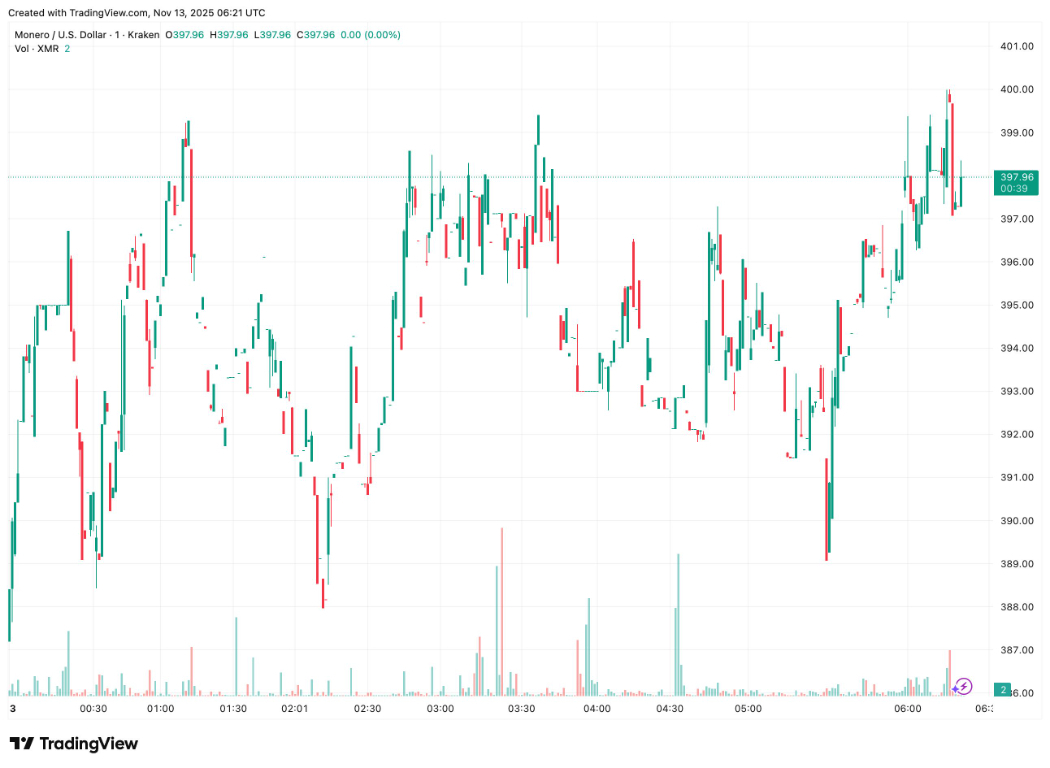Monero’s intraday volatility has tightened into a narrow $387–$398 range. When volatility compresses this tightly, it often signals that a larger move is building up beneath the surface.
Price Action Points to a Controlled Uptrend

XMR Price | Source: TradingView
XMR is trading above its 20-day SMA ($388.52) and 50-day SMA ($381.32), both of which are rising. This indicates that short- and medium-term momentum has shifted decisively in favour of buyers.
The 200-day SMA (~$378.12), once a persistent ceiling, has begun to flatten and transition from resistance into long-term support.
The RSI is around 55, which reflects buyers solidly in control without pushing the market into overheated levels. The MACD (12/26) is firmly positive at 4.08, with a widening separation between MACD and signal lines, a sign that the underlying trend has conviction.
Shorter-term oscillators, however, tell a different story. The Stochastic RSI above 82 and the Williams %R around -12.69 indicate overbought conditions on lower timeframes. These readings often precede intraday dips or sideways drift rather than full-scale reversals.
In other words, the broader trend is strong, but the immediate pace may temporarily cool.
Market Participation Rises Without Excess Leverage
Market participation around Monero’s advance has grown steadily. Spot volume remains strong between $180m and $200m. This suggests real demand rather than low-liquidity drift. Derivatives activity reinforces this: perpetual futures open interest sits around $70–$72m, a level that signals firm engagement without signaling reckless leverage.
Funding rates are modestly positive, indicating some tilt toward long positions but nowhere near the overheated conditions that usually precede sudden long-liquidation cascades.
The takeaway is straightforward. Monero’s climb is being driven by a healthy mix of spot buyers and measured futures activity, not speculative excess.
On-Chain Activity Reflects Steady, Utility-Driven Usage
While price action has strengthened, on-chain behaviour has remained characteristically stable. Transaction counts are moving within their normal ranges, which reinforces Monero’s steady baseline of real-world usage.
Earlier this week, exchange outflows increased as XMR traded through the $380s, hinting at accumulation from longer-term holders rather than short-term speculation. Monero’s privacy-focused design typically results in “sticky” holders, and the current environment supports that pattern.
No dramatic on-chain surges, no collapses, just consistent activity that forms a reliable backdrop for price expansion.
Key Levels Will Define Monero’s Next Major Move
Monero is approaching a layered resistance zone rather than a single ceiling. The first test lies around $395–$405, where supply has repeatedly slowed momentum. Above that sits the more important $415–$420 cluster, which has rejected multiple rallies in recent months.
If Monero clears $420, it enters its strongest technical condition in months, with room to advance into the $445–$460 region, the next structural pocket of interest.
On the downside, initial support appears between $372 and $380, while deeper structural support, the level that has held multiple cycles, lies around $350–$360. A breakdown below $350 would likely send XMR back toward the $300–$330 macro floor.
Top Forex Brokers
Final Thoughts
Monero’s recent performance shows steady bullish strength with improving trend structure, healthy volumes, rising participation, and consistent on-chain behaviour. It now sits beneath one of its most important resistance zones of the year, making the coming sessions potentially decisive.
A breakout through $400–$420 could shift sentiment across the privacy-coin market broadly and set XMR on a new trajectory. Failure to clear this region would likely lead to another consolidation drift back toward the mid-$360s.
For now, XMR remains well-positioned, gradually strengthening, technically improving, and inching toward a meaningful inflection point.
